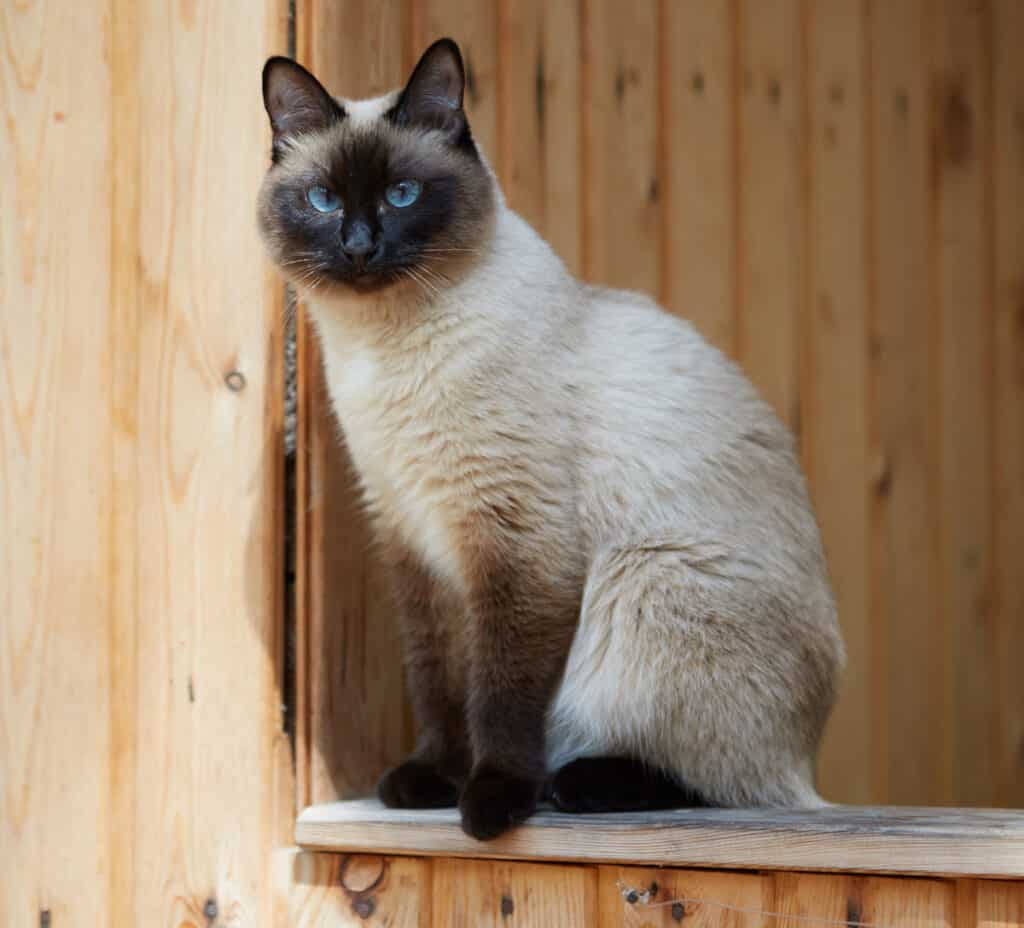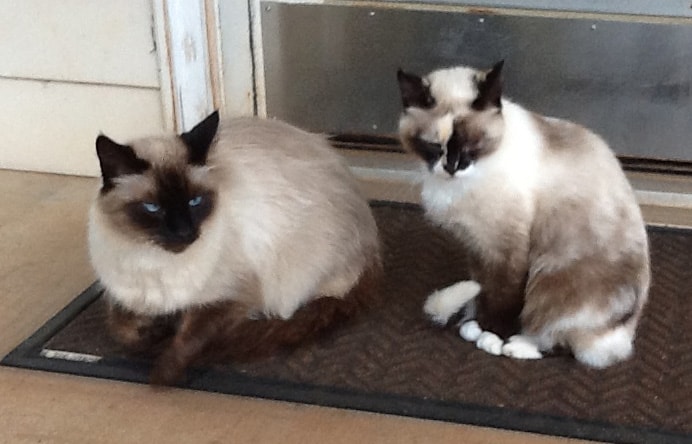Siamese cats are known for their striking blue eyes, sleek body, and distinctive coloring.
Origins of the Siamese cat
The modern Siamese cat is descended from the Wichianmat, a landrace cat, also known as the Thai cat, Traditional Siamese cat, and Old-style Siamese cat. It is believed that the Siamese breed was developed through selective breeding of the Wichianmat.
Siamese cats are one of the oldest cat breeds, dating back to at least the 14th century in Thailand (Related: How Thai People Felt About Cats in the 19th Century)
National Siamese Cat Day
Siamese cats get their own celebration day on April 6 each year with National Siamese Cat Day.
What do Siamese cats look like?
One of the most distinctive characteristics of the Siamese cat is its coloring. Siamese cats have a color pattern known as colorpoint.
Siamese cats have a light-colored body with dark points on their face, ears, paws, and tail.
The most common coloration is seal point, which has dark brown points, but there are also blue point, chocolate point, and lilac point Siamese cats.

Siamese cats have a long face compared to the Thai cat, which is know for its “apple-like” face shape.
Newborn Siamese kittens are born white
Siamese cats are colorpoints. This means that their fur coloration is drive by heat. Colorpoint cats have a form of partial albinism as a result of a genetic mutation affecting tyrosinase.
Tyrosinase is an enzyme that affects melanin production. At normal body temperatures, this enzyme fails to produce color as a result of this mutation. In a colorpoint cat therefore, the enzyme only produces melanin (and pigmentation) in the cooler parts such as the ears, tail, and paws.
In the womb, the heat is evenly distributed which in turn suppresses the production of pigmentation. As a result, newborn Siamese kittens are one uniform white color. The kittens start developing their points a few weeks after birth.

Siamese cats are talkative
Siamese cats are known to have a wide range of vocalizations, from quiet chirps to loud, distinctive yowls, and they may use different sounds to express different emotions.
Researchers found that Siamese cats tend to initiate contact and be more vocal than some other breeds of cats. There are several reasons why this may be the case.
Siamese cats are social
One reason is that Siamese cats are very social animals and enjoy interacting with their owners. They may use vocalization as a way to communicate their needs and desires, and to express their feelings.
Researchers have found that because of their outgoing nature, Siamese cats are also more prone to separation anxiety as compared to other cat breeds.

Siamese cats are intelligent
Another reason why Siamese cats are so talkative is that they are a highly intelligent breed. Siamese cats are quick learners and can be trained to perform a variety of tricks and behaviors, and they may use vocalization to express their eagerness to learn and participate in activities.
Siamese cats may have been selectively bred for their vocal nature
Finally, some experts suggest that the vocalization of Siamese cats may be related to their breeding. Siamese cats were originally bred in Siam (now Thailand), where they were known for their vocalizations.
It is possible that over time, the breed developed a greater inclination toward vocalization as a result of their breeding history.
The first Siamese cat in the United States
In 1879, the first Siamese cat to arrive in the United States was a feline named Siam. David B. Sickels, the American consul in Bangkok, Thailand, presented Siam as a gift to President Rutherford B. Hayes and First Lady Lucy Hayes.
In a note address to President Hayes written on November 1, 1878, Sickels wrote, “I have taken the liberty of forwarding you one of the finest specimens of Siamese cats that I have been able to procure in this country . . .I am informed that is the first attempt ever made to send a Siamese cat to America.”
Siam quickly became an adored pet of the First Family and was frequently spotted lounging in the White House. Siam’s arrival in the United States was a crucial moment in the Siamese cat’s history, sparking interest in the breed among American cat lovers and leading to further imports of Siamese cats from Thailand and other countries.
There have been three presidential Siamese cats in the United States
Siam wasn’t the only Siamese cat to take up residence in the White House.
In 1974, Susan, the daughter of President Gerald Ford, brought her Siamese cat named Shan to live with her at the White House. Misty Malarky Ying Yang was the name of the cat owned by Amy, the daughter of President Jimmy Carter.

Siamese cats in media
Siamese cats have been featured in various forms of media, including literature, film, television, and even music.
Siamese cats have been featured in a number of books, including the “Cat Who” series by Lillian Jackson Braun, “The Incredible Journey” by Sheila Burnford, and the “Cat Royal” series by Julia Golding.
Skippyjon Jones is a popular children’s book character created by Judy Schachner. He is a Siamese cat who imagines himself to be a chihuahua, and he goes on adventures with his imaginary chihuahua friends. Skippyjon Jones is known for his mischievous personality, his boundless energy, and his love of adventure.
Siamese cats have been featured in several popular films, including “The Lady and the Tramp,” where the Siamese cats Si and Am sing the memorable song “We are Siamese if you please.” Two Siamese cats also called Si and Am make a brief appearance in “The Aristocats.”
References
Wilhelmy, J., Serpell, J., Brown, D., & Siracusa, C. (2016). Behavioral associations with breed, coat type, and eye color in single-breed cats. Journal of Veterinary Behavior, 13, 80-87. https://doi.org/10.1016/j.jveb.2016.03.009
Related







